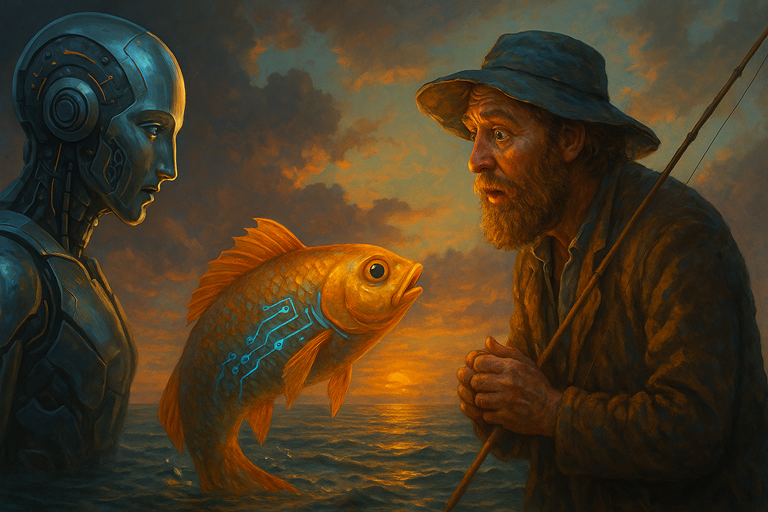🤖 Artificial Intelligence and the German Fisherman Legend; A Narrative of Humanity's Future 🎣
Introduction ✨
When we try to explain the complexities of new technology, numbers and charts tell only part of the story. Sometimes, the best scale to measure the impact of a technology is through stories and legends passed down through generations Clemens J. Setz, in an article for The Guardian, uses the German legend of “The Fisherman and His Wife” to explore humanity’s relationship with artificial intelligence He explains how having a “magical fish in your pocket”—like a smartphone or generative AI models—can instantly fulfill desires and how this might transform our identity, ethics, and social structure
Legend at a Glance 📖
The short version of the legend is this: a fisherman catches a magical fish and then releases it. His wife learns about it and begins making a series of requests and wishes from the fish: starting with a better house, progressing to a palace, high-ranking positions, and ultimately wishing to “become God.” In the end, when the final wish becomes excessive, the fish takes everything back, and the couple returns to their original state
?Why Does Setz See the Fish as AI 🤔
The core metaphor of Setz is simple: just as the fish in the legend fulfilled every wish, today generative AI models (from text writing to image creation and virtual role-playing) can instantly provide what we want. This uninterrupted access to wish fulfillment brings three major changes:
Reduced Resistance and Friction
There is no longer a need for effort or waiting. Quick and easy experiences make processes smoother.
Intensified Desires
When something becomes easy, wanting more becomes tempting, and people start demanding more.
Cost Shifting
Environmental, economic, and social impacts may remain behind the scenes and be absorbed by producers or infrastructure, rather than by direct consumers.
Three Possible Future Paths 😶🌫️ / 🌱 / 😔
Setz envisions three broad futures for humanity with the “magical fish”: Decadence, Artificial Hardship, and Guilt as Structure. Below is a brief explanation followed by an expansion of each path.
Decadence
Unlimited abundance of AI-generated services and entertainment
Main Risk: Loss of meaning and collective motivation
Artificial Hardship
Creating artificial obstacles to restore the sense of effort’s value
Main Risk: Handmade or performative forms of resistance or elitism
Guilt
Voluntarily limiting desires due to ethical or environmental consequences
Main Risk: Cultural judgment and exploitation that undermine individual freedom
? Expanding the Three Paths — What Happens 🔍
Let’s examine each path with concrete examples and narratives
Imagine a version of the world where every immediate need is fulfilled with a click: personalized music, stories written for you, virtual companions who never tire. In the short term, this world is delightful; in the medium term, however, meaning disappears. Achievements, sensitivity, and collective concepts of shared effort become diluted
Some react by creating networks that require passing tests or artificial queues; groups that confer value through the difficulty of achievement. The problem is that these hardships can lose authenticity and turn into a “display of value”—similar to luxury-ifying effort.
If every wish comes with an ethical or environmental bill—e.g., “This request emitted x grams of CO₂”—people begin to self-censor. They limit their desires, blame themselves, and gradually lose freedom of choice, while power structures continue benefiting themselves.
Quotes and Additional Perspectives 📚
“Many young people today grow up with a magical fish in their pocket.” — Reinterpreting Clemens J. Setz 🔗 (The Guardian)
: A few familiar voices that complement or challenge Setz’s perspective
Sherry Turkle: “Technology doesn’t just change what we do; it changes us”
Nick Bostrom: “We are like children playing with a bomb”
Yuval Noah Harari: “When AI knows us better than we know ourselves, we no longer know what we truly want”
? Critique of Setz’s View — What Is Overlooked 🧐
Setz presents a strong and cautionary picture, but there are a few weaknesses or areas that need supplementation
Risk of Technological Determinism
Paths are not predetermined. Laws, education, and culture can change direction
The Fish Isn’t Nameless — It Has Owners
In the real world, the “fish” belongs to companies, governments, and algorithm creators. Ownership and incentives create uneven distribution of costs and benefits
Diversity of Motivations and Desires
Desires are not only consumptive; many are based on meaning, collaboration, and limits AI can amplify these desires.
Fragility of Guilt as a Moral Barrier
Relying solely on conscience or guilt to control technology is fragile and may lead to dissatisfaction or blame on weaker groups
? How Can We Build “Designed Resistance” 🛠️
If the goal is to build a world where AI is a tool for growth rather than collapse, resistance must be embedded in design — features that allow growth, learning, and conscious choice
- Add Useful Friction: Before providing a complete answer, AI asks users follow-up clarifying questions
- Transparency of Costs: Display explanations about energy and data usage for each request
- Challenge Mode: Encourage learning and testing paths instead of providing an easy solution
- Collective Goals: Encourage using AI for shared purposes instead of individual consumption
- Rules and Public Ownership: Policies that regulate data ownership, algorithm transparency, and benefit distribution
Modern Narrative: Ilsebill in 2035 👵📱
Imagine Ilsebill today: she no longer needs to go to the sea or catch fish. She talks to her phone and says: “Write me a novel.” — “Create a virtual friend for me.” — “How can I become popular?” All of these are delivered quickly and pleasantly. But each answer comes with a small note: This request consumed X liters of water and produced Y grams of CO₂
Initially, Ilsebill feels shame and then self-limitation. Wishes decrease; pleasures are fewer, but the psychological pressure of decision-making increases. The freedom to desire gradually fades, and life becomes a moral performance
Questions for Reflection and Discussion 🗣️
- ? If you had a “magical AI fish” in your phone right now, what would your first wish be 🎯
- ? Do you think guilt can be a lasting barrier against technological greed, or does it accelerate moral decay 😶🌫️
- Which of the design suggestions above (transparency, challenge mode, collective goals) appeals to you the most,Why
?
- ? What new fairytale or legend would you like to write for children in the AI era ✍️
? Conclusion — How to “Wish Wisely” 🌟
Clemens J. Setz, by reinterpreting a simple fairytale, invites us to confront a fundamental question: Do we hand over control of our desires to technology, or do we manage them rationally and collectively? The magical fish symbolizes both possibility and risk
We do not need to destroy the fish — we only need to redesign how we interact with it. AI can become a support for creativity, empathy, and collaboration if it embodies constructive resistance, transparency, and accountability.
Sources and References: Original article by Clemens J. Setz in The Guardian 🔗

